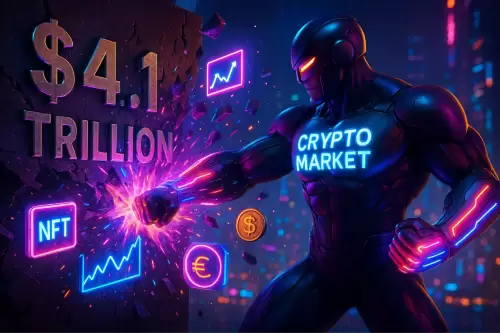 |
|
 |
|
 |
|
 |
|
 |
|
 |
|
 |
|
 |
|
 |
|
 |
|
 |
|
 |
|
 |
|
 |
|
 |
|
Cryptocurrency News Articles
Bitcoin in 2030: Guessing Games and Market Realities
May 19, 2025 at 01:27 pm
Trying to pin down Bitcoin's (BTC) price for 2030 is a wild ride, a journey through a maze of different math models, expert guesses, and the market's unpredictable nature.

Trying to nail down Bitcoin's (BTC) price for 2030 is a wild ride. It takes us through a maze of different math models, expert guesses, and the market's own unpredictable nature. The range of guesses is huge, and they're cooked up from all sorts of methods that look at old price moves, how fast people are starting to use it, big-picture money trends, and what makes Bitcoin special, especially its unchangeable, limited coin count.
Those guesses vary massively, from a low of around $140,000 in some models to Cathie Wood, founder of Ark Invest, suggesting a potential high of $1 million to $1.5 million by 2030.
Who's Saying What About Bitcoin's 2030 Price
Several well-known figures and institutions have shared their predictions for Bitcoin’s price in 2030, presenting a diverse range of outlooks.
How They Come Up With These Numbers
The techniques used to arrive at these predictions are varied and often combine different approaches to value investing, technical analysis, and fundamental analysis.
Most upbeat price predictions assume that:
* Demand for Bitcoin will continue to rise rapidly.
* Greater numbers of everyday investors, large investment firms, corporations, and potentially even governments will be investing in Bitcoin.
* Bitcoin’s scarcity will become an increasingly important factor as the total supply is limited to 21 million coins, and its mining rate will slow down with each halving event.
* The current bull market in cryptocurrencies will continue.
* A large portion of the "lost" Bitcoin is permanently inaccessible, effectively reducing the circulating supply.
* Major macroeconomic trends will remain favorable for Bitcoin.
* Central bank digital currencies (CBDCs) will be widely adopted by 2030.
* Significant technological advancements will occur within the Bitcoin network or Layer 2 solutions.
What Most Upbeat Guesses Assume
One thing most of the super-positive predictions have in common is they expect more and more people to want Bitcoin - from everyday folks to big investment firms, companies, and maybe even countries. The fact that there will only ever be 21 million Bitcoins and that its supply schedule is set in stone and open for anyone to see is a basic building block for almost every long-term price guess.
A big reason for optimism you hear a lot is the idea that tons of money from institutions will be flowing into Bitcoin, especially through easily bought vehicles like Exchange Traded Funds (ETFs). Plus, many models assume Bitcoin will cement its reputation as a good way to hedge against inflation and a reliable store of wealth, maybe even better than gold.
While new laws and regulations are always a bit of a wildcard, lots of long-term guesses either quietly or openly expect them to change in ways that help, or at least don't badly hurt, Bitcoin's growth and use. That the Bitcoin network itself will keep running safely and smoothly, and get even better with new additions (Layer-2 solutions), is often an unspoken but super important assumption.
The Wide World of 2030 Guesses
The variety of Bitcoin price predictions for 2030 is staggering, showcasing the vast uncertainty and diverse starting points of different predictive methods.
Bitcoin's Price Rollercoaster and the Halving Effect
Since Bitcoin's journey began in 2009, its price has been on a wild ride, with rapid surges and substantial drops, charting several clear boom and bust cycles. This volatility is a product of various factors, but the “halvings,” events programmed into Bitcoin to decrease the rate at which new coins are added to the system, play a significant role in how it's valued.
Breaking Down Bitcoin's Price Swings:
* Bitcoin's price history is a story of swift advances (bull markets) interrupted by deep declines (bear markets).
* It's worth noting that some market watchers believe that each bull cycle is bringing smaller percentage gains, although the entire cryptocurrency domain is still relatively new and in the process of finding its footing.
How Halvings Shake Things Up:
Bitcoin's halvings are a core part of its design. Approximately every four years, or after 210,000 blocks of transactions are mined, the reward that miners receive for verifying transactions is cut in half. This mechanism is intended to slow down the rate of Bitcoin's inflation and ensure that the total supply never exceeds 21 million coins. These events are often followed by price increases as they decrease the number of new Bitcoins entering circulation, potentially making them scarcer if demand remains stable or grows.
Looking back at past halvings and what appeared to happen:
* 2012: The first halving occurred in November 2012, reducing the block reward from 50 BTC to 2
Disclaimer:info@kdj.com
The information provided is not trading advice. kdj.com does not assume any responsibility for any investments made based on the information provided in this article. Cryptocurrencies are highly volatile and it is highly recommended that you invest with caution after thorough research!
If you believe that the content used on this website infringes your copyright, please contact us immediately (info@kdj.com) and we will delete it promptly.






























































